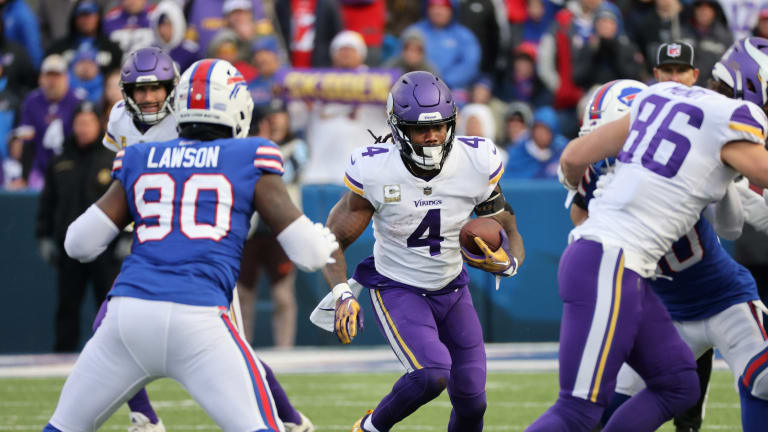
Instant reaction: Vikings to part ways with Dalvin Cook

NFL Network’s Tom Pelissero reported on Thursday that the Minnesota Vikings will soon part ways with their Pro Bowl running back Dalvin Cook.
The interesting part is that they didn’t have to do this.
Earlier in the offseason when we were talking about the Vikings releasing or trading Cook, it was always through the lens of salary cap troubles. If you logged onto OverTheCap.com at any given time during the spring you would see the Vikings’ cap space number look similar to the tip you’d give at Applebees.
But after restructuring Kirk Cousins’s deal and releasing Eric Kendricks and Adam Thielen and using a little void-year action on Byron Murphy Jr. and Marcus Davenport’s contracts and trading Za’Darius Smith to the Cleveland Browns, the Vikings aren’t that bad off with the cap. Per OTC, they have about $9.7 million.
Certainly they would like some extra space to push Justin Jefferson/TJ Hockenson’s extension dollars into 2023 but otherwise they were not forced to move on from Cook. If the Vikings believed that he was going to help them scamper their way deep into the playoffs this season, they would have found a way to make sure he remained in purple. That’s what they have always done in the recent past with veteran stars, even if there were concerns in projecting future production.
This is the approach that savvy Vikings fans were looking for from the past regime. One where it’s better to move on a year too early rather than a year too late. One that sees the age curve’s warning flares and cares about the PFF grade dipping and the Rushing Yards Over Expected falling. One that worries more about projecting future production from the position than the reputation and popularity of the player.
Let’s take a closer look at some of those numbers.
— Cook’s PFF grades went from 81.3 and 89.0 in 2019 and 2020 to 65.8 and 67.4 over the last two seasons. That’s the difference from ranking as the second best RB in the league behind Derrick Henry to 50th out of 60 regular and rotational backs.
— In 2020, his Rushing Yards Over Expected was 0.44 per rush in 2019 and 0.81 in 2020. Both those stats are elite. In 2021 it was still decent at 0.34 but last year his RYOE dropped to minus-0.16 per carry, among the lowest in the NFL.
— His yards per touch went down for four straight years, dipping from 5.5 in 2020 to 4.8 last year.
— In August, 2021, PFF published a look at when running backs tend to fade and identified the 1,500 touch mark as the concerning level of workload before going over a cliff. Cook has 1,503 carries + receptions.
Is it possible that Cook could have come back stronger this year, fresh off shoulder surgery, and improved on those numbers? Certainly. There have been lots of running backs who have thrived in their age-28 season and beyond. Since 2010, 33 RBs have gone for over 1,000 yards at either 28 or older. Only 16, however, have averaged 4.5 yards per carry or above and two of those seasons belong to Adrian Peterson.
Another inefficiency that exists below the surface with Cook is the obligation to use him. If any other running back went through downturns as he did in the second halves of seasons and had injuries slowing them down, coaches would have limited their carries and mixed in other runners. But the bell cow was the bell cow and he was getting the football no matter how many limbs were dangling.
Keeping in mind that QB rushing is included, it’s still noticeable that the Vikings were 27th in Expected Points Added on the ground last year, 28th in 2021, eighth in 2020, 16th in 2019 and 28th in 2018. So, an above average rushing game in totality once in the last five years. They can improve on that.
Naturally, you will see football analysts abound saying that the Vikings have one of the worst backfields in the NFL now. One way of looking at that is the obligation to get Cook his touches is now gone so they can throw, throw, throw. That seems like a good strategy considering the group of pass catchers.
But we also can’t say for certain that it won’t be more efficient than the last two years with Alexander Mattison, Ty Chandler, Kene Nwangwu and DeWayne McBride. Some of the running backs who produced better PFF grades and yards per carry than Cook last year included Brian Robinson Jr., Rhamondre Stevenson, Chuba Hubbard, Dameon Pierce, Raheem Mostert, Isiah Pacheco, Devin Singletary etc. We often see circumstances determine success in the backfield. Remember when Latavius Murray and Jerick McKinnon starred in 2017?
Being star-studded in the backfield doesn’t always mean being the best you can be. Or the best you can be for the future. The Vikings have spent third, fourth, fifth and seventh-round draft picks on their current crop. It’s time to find out who can play.
This year might be about finding out who can play in general— just look over at the defensive side of the ball. There’s a lot of value in that.
So it won’t be easy for fans with No. 33 or No. 4 jerseys to see another very good player walk out the door. Once upon a time, folks with No. 28 jerseys weren’t thrilled to see an all-time running back walk out the door and the next man up was able to thrive. That’s the nature of the position and the Vikings are handling it as if they know that now.







